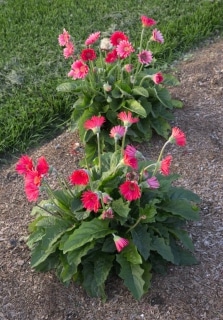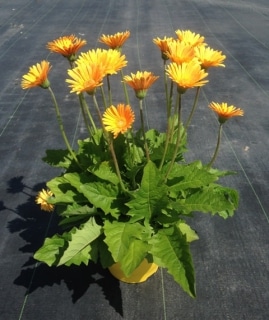A garvinea flower is a variety of Gerbera that is hardy and can thus be grown in the garden anytime of the year.
Key Garvinea facts
Name – Gerbera jamesonii Garvinea® hybrid
Family – Asteraceae (the daisy family)
Type – perennial
Height – 12 to 16 inches (30 to 40 cm)
Exposure – sun or light shade
Soil – normal to acidic
Foliage – evergreen
Flowering – May to October
Planting a garvinea
Garvinea is a perennial gerbera that blooms abundantly. It only fears freezing below 23/25°F (-4/-5°C).
A garvinea seedling can be planted indifferently in spring or fall.
- This plant loves sun and likes being protected from strong winds.
- Frequent watering after planting is recommended.
- Place plants about 16 to 20 inches (40 to 50 cm) apart.
Propagating Garvinea
Propagation is possible in spring through crown division or by sowing seeds in a tray towards February-March.
In greenhouses of authorized growers, cloning ensures that the plant remains true to shape. This vegetative propagation ensures that patent rights are respected.
- Crown division is a form of vegetative propagation (or plant cloning).
Garvinea winter care
Although it resists the cold well, it is however vulnerable to deep frost spells, which means you must protect it whenever temperatures drop below 25°F (-4°C).
- Proper dried leaf mulch or horticultural fleece should do the trick.
- For pots or garden boxes, bring your garvinea in a well-lit, cool but non-freezing room.
Watering and fertilizing garvinea
 Regular but moderate watering is called for. The Gerbera Garvinea® requires little water but quite often, in order to keep the soil slightly moist.
Regular but moderate watering is called for. The Gerbera Garvinea® requires little water but quite often, in order to keep the soil slightly moist.
The strength of the Garvinea® series is its hardiness which enables it to grow outdoors as a perennial even in colder climates.
In spring and summer
If in a pot or a garden box, keep the soil mix a bit moist and check that water drains properly.
Provide liquid leaf plant fertilizer more or less once a month to extend the blooming to the maximum.
- Water from above, ideally with water that isn’t hard.
- Never wet the leaves and flowers of your Garvinea®.
To retain a certain moisture level, it is best to put the pot or garden box on a bed of clay pebbles wallowing in water.
In fall and winter
No specific watering is needed during this part of the year, since rain usually fulfills the water needs of the plant.
- If your Garvinea are in pots in places where rain doesn’t fall, water at most once a month.
Common Garvinea® diseases & pests
Compared to regular Gerbera, caring for Garvinea is a breeze. They are much more resilient and resistant. This makes them better-suited to planting outdoors.
However, you might still encounter the following issues:
Pests that attack Garvinea plants
Most pests to expect are common gerbera foes such as aphids, red spider mites, scale insects.
Garvinea when grown outdoors is particularly vulnerable to aphids. To avoid this, spray it often with a pyrethrum-based insect killer (a Chrysanthemum extract).
- Another option is to plant “decoy plants” that will attract the aphids away. Typical examples of this are nasturtium and cosmos.
- Read more about the relationship between nasturtium and aphids.
- Lastly, there are a host of fermented tea recipes that can help fight off aphids.
Luckily, slugs and snails don’t like Garvinea too much. They will always prefer other softer plants, like Hosta or lettuce in the vegetable patch. This is in part due to the slightly fuzzy leaves.
Diseases that infect Garvinea
Powdery mildew – leaves are covered with whitish dust and then turn yellow and die.
Leaves grow smaller and smaller – need to consider repotting your garvinea when it’s container-grown.
Chlorosis – leaves turn pale and yellow – either due to lack of fertilizer (use fermented nettle, a great garden fertilizer) or excessively hard water for container-grown plants.
Septoria – fungal disease that results in leaf spots. Learn more about how to prevent and treat Septoria
Many Gerbera Garvinea varieties
All Gerbera Garvinea® varieties derive from recent developments by Florist Holland BV, a Holland-based enterprise that continuously works on new garvinea varieties.
There are also dozens more beautiful Garvinea flowers. Usually they’re marketed in different series.
Garvinea Sweet Series
This is the most recent series. Above, the two ‘Sweet Surprise‘ and ‘Sweet Dreams‘. Topmost article picture is the ‘Sweet Glow‘ and bottommost is the ‘Sweet Honey‘. Additionally, you can find these:
- Garvinea Sweet Smile – sunflower-yellow color
- Garvinea Sweet Caroline – copper orange color with petal tips and center bright yellow
- Garvinea Sweet Candy – cotton-candy pink petals with a white center
- Garvinea Sweet Love – deep red, bordering on bordeaux maroon
- Garvinea Sweet Memories – short, pastel pink petals and generous white heart
- Garvinea Sweet Heart – fluorescent pink petals, twice a broad, with pale pink heart
- Garvinea Sweet Sixteen – stark pink petals, thin and numerous with a heart of the same color
- Garvinea Sweet Spice – deep pink petals with a dark, white-rimmed center. Roundish petal tips
- Garvinea Sweet Fiesta – double row of violet, white-tipped petals
- Garvinea Sweet Sunset – two-color petals, deep orange outside and vivid yellow inside, with a black orange-rimmed heart
Garvinea Classic series
This is the first set of Garvinea developments. Here are a few more in addition to the ‘Fleurie’ shown above.
- Garvinea Classic Sylvana – pure white with a yellow center. Easily confused with the normal daisy flower.
- Garvinea Classic Sunny – sunflower-yellow with pale yellow-green heart
- Garvinea Classic OrangIna – pale green heart, orange petals tapering to yellow
- Garvinea Classic Kendall – astounding coral pink color with a small yellow heart
- Garvinea Classic Rachel – deep coral red color with light green heart
- Garvinea Classic Sophie – bright red with a yellow-rimmed pale green-white heart
- Garvinea Classic Lydia – pink petals with light green heart
- Garvinea Classic Pam – slightly darker pink than the Lydia, with a dark heart
- Garvinea Classic Isabel – bright yellow with pitch-black heart
- Garvinea Classic Jasmina – not fragrant, sadly! Pink petals with cute white-yellow heart.
- Garvinea Classic Jilly – coral orange with a coral and pale green heart
- Garvinea Classic Lauren – white petals with a white and yellow heart
- Garvinea Classic Layla – short, neon pink petals with a large pink-rimmed white heart
- Garvinea Classic Lilian – short, pink petals with a large orange-rimmed green heart
- Garvinea Classic Lisa – short neon pink petals with a pale pink rimmed white heart
- Garvinea Classic Piroska – pale pink petals that finish off white, with a light yellow heart
- Garvinea Classic Romy – bright red petals, short, with a huge peach-colored heart
- Garvinea Classic Valerie – pearl-like hues of light pink and violet, yellow heart
- Garvinea Classic Vivian – hay-yellow petals and heart
- Garvinea Classic Cindy – lush shade of light red tapering to white edges, yellow center
- Garvinea Classic Nikki – white-toned blooming with a black dot in a yellow rim
Garvinea Spider series
These are surprising because the petals are much thinner and longer, giving the flowers a spindly, spidery look!
- Garvinea Spider Amalia – red-orange petals with a golden yellow center
- Garvinea Spider Anestasia – elegant ivory yellow petals with a pale green center
- Garvinea Spider Catherine – pure white petals with a small white center
- Garvinea Spider Charlotte – sun-yellow through and through
- Garvinea Spider Letizia – deep red-pink petals with fruit orange heart
- Garvinea Spider Madeleine – shimmering pastel coral petals with a buttercup golden yellow heart
Garvinea Botanic series
Flowers are smaller on these particular specimens.
- Garvinea Botanic Tinkerbell – again, similar to daisies with a gold yellow heart and pure white petals
- Garvinea Botanic Cinderella – bright yellow petals with a deeper shaded yellow heart
- Garvinea Botanic Santana – pastel yellow petals and heart, evanscent color
- Garvinea Botanic Sleeping Beauty – white petals with fun violet underside, yellow heart with black dot at center
- Garvinea Botanic Summer – large yellow petals and heart, slightly orange underside
Every season sees new specialties appear!
Learn more about Gerbera Garvinea
 A fabulous perennial plant, the Garvinea® bestows us with daisy-shaped flowers that are pink, red, yellow, orange or simply white.
A fabulous perennial plant, the Garvinea® bestows us with daisy-shaped flowers that are pink, red, yellow, orange or simply white.
The normal lifespan of a Garvinea® usually doesn’t extend longer than 3 years. You’ll have to replace it after this time span.
Garvinea, a patented plant
Gerbera Garvinea has been on the market since 2009. A plant patent protects the rights of the breeder who worked hard to develop this hardy variety for us. Propagating the plant for resale is not allowed without authorization.
- You can, however, propagate your Garvinea to replace a dying one.
- This patent explains why the “®” appears when mentioning Garvinea.
- There are several plant patents, usually one per variety. They were attributed from 2006 onwards and will normally expire after 20 years.
Where does Garvinea come from?
Garvinea was developed from the more popular Gerbera jamesonii variety (also called the Barberton daisy), crossed with other, hardier Gerbera. Gerbera ambigua is among these other parent plants.
The goal was to create a hardier plant that would boast a stronger root system and leaves that held better to frost.
Whereas normal Gerbera die when it freezes, a Garvinea flower will at most lose its leaves and flowers. When Spring and warm weather return, it will grow back and bloom.
Smart tip: Garvinea flowers in a bouquet
To preserve your garvinea as long as can be in a bouquet, it’s important to use clean water in a vase that has been thoroughly cleansed.
- Replace the water in the vase regularly.
This type of gerbera is also very beautiful as a floating flower as a decoration on a reception table for instance.
Read also:


 Regular but moderate watering is called for. The Gerbera Garvinea® requires little water but quite often, in order to keep the soil slightly moist.
Regular but moderate watering is called for. The Gerbera Garvinea® requires little water but quite often, in order to keep the soil slightly moist. A fabulous perennial plant, the Garvinea® bestows us with daisy-shaped flowers that are pink, red, yellow, orange or simply white.
A fabulous perennial plant, the Garvinea® bestows us with daisy-shaped flowers that are pink, red, yellow, orange or simply white.